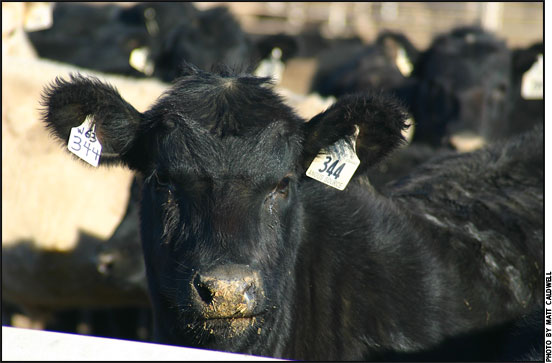 Insuring Against Volatility
Insuring Against Volatility
Livestock Risk Protection insurance is an option to manage volatile cattle prices.
As price volatility continues to make headlines, cattle producers looking to better manage risk may want to consider the Livestock Risk Protection (LRP) insurance that is available. The pilot program, which has been available for the last few years, offers coverage for feeder cattle and fed cattle, allowing producers to limit downside price risk while still being able to take advantage of higher prices.
Melissa Stearns of Edgemont, S.D., is a crop insurance agent licensed to offer LRP to cattle producers in South Dakota, Nebraska and Wyoming. She explains that LRP is very similar to a put option on the futures market, with one distinct advantage. LRP insurance allows a producer to insure as few head of cattle as he or she wants to — whereas feeder cattle put option contracts must be purchased in 50,000-pound (lb.) increments.
LRP insurance is presently available for fed cattle (1,000-1,400 lb.); feeder cattle (steers and heifers up to 900 lb.); lambs and swine. All livestock must be owned by the individual or entity insuring the livestock at the time the insurance is purchased.
How LRP Works
If you chose to purchase LRP insurance on a group of feeder calves, an expected ending value is estimated at the time the insurance is purchased. This expected value is the current futures price of the cattle for the month in which they will be sold. The producer then chooses the level of coverage desired. This level can be between 70% to 100% of the expected ending value, explains Stearns.
The premium is then calculated based upon the level of coverage chosen.
Once the insurance period is over, the coverage price chosen by the producer at the beginning of the contract is compared to the actual ending value. This value is a seven-day rolling national average for 700- to 849-lb. medium or medium/large No. 1 framed steers.
• If the actual ending value is larger than the coverage price, then no indemnity will be paid to the producer. The loss to the producer is the premium paid.
• If the actual ending value is less than the coverage price, then an indemnity is paid, which is simply the coverage price minus the actual ending value. If the indemnity is collected, the gain from the LRP insurance is the indemnity minus the premium paid.
As an example, Stearns reports that the insurance has been popular this spring, especially with yearling prices for August futures reaching $135 for 900-lb. steers and $123 for heifers.
She explains that if the actual cash price in August for 900-lb. steers or heifers is lower than those prices being locked in now, the producers with LRP insurance will receive a payment for the price difference minus the premium.
Stearns notes that LRP does have a notable cost. "The premiums are there," she says, but adds, "It's a product worth looking at, especially when the cattle market has shown such volatility these past few years."
And, presently, the premium is subsidized 13% by the federal government because it is trying to create more awareness — and participation — in this pilot program, states Stearns.
She clarifies that LRP is slightly different than most crop insurance products, because the premium is due at the time of signing the LRP application.
She also explains for producers that the "target weight" for livestock need only be an estimate at the time of purchasing the insurance, and there are no negative impacts if the actual ending weight is higher or lower. The target weight will be the weight the loss check is based from. For instance, if a target weight of 580 lb. is estimated, but the actual weight is 600 lb., the insurance loss would be paid on 580 lb. if the cash price is lower than the insurance price that was locked in.
Stearns anticipates that as price volatility continues, interest in LRP coverage will continue to grow, as well.
"I'm seeing more bankers recommend to cattle owners that they need to do something to protect themselves from the price risk in the market. The LRP insurance program is a relatively easy way to do that without the use of the futures market," she concludes.
South Dakota State University livestock economist Matt Diersen reiterates that LRP insurance contracts can be purchased for yearlings or for calves to be marketed this fall. He says the main drawback he's seen is that there is not always an end date offered on contracts that matches up with the sale date for calves.
"This can be frustrating for producers and insurance agents alike," says Diersen.
More LRP details
LRP insurance policies are available through the crop insurance agent system, through agents specifically trained to sell LRP.
LRP can be purchased once the markets close for the day and until the market opens the following day, and Saturday morning until 9 a.m. (Central Time).
There is a maximum limit of 4,000 head of fed cattle and 2,000 feeders that an owner can insure per year.
 If the livestock are sold during the contract, insurance may be transferred to the new owner. If livestock are sold prior to 30 days before the expiration of the contract and no transfer of insurance is completed, the insurance is null and void and no premium is earned.
If the livestock are sold during the contract, insurance may be transferred to the new owner. If livestock are sold prior to 30 days before the expiration of the contract and no transfer of insurance is completed, the insurance is null and void and no premium is earned.
The LRP program is made available through a federal mandate that aims to level the playing field and make an equivalent number of insurance products available for livestock owners as are offered to grain producers.












